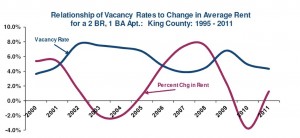2014: The Year of Housing Supply
As part of announcing our new partnership supporting the work of Smart Growth Seattle, I was asked to speak at the Seattle Metropolitan Chamber of Commerce’s Community Development Round Table (CDRT). I spoke to the CDRT about 15 years ago about neighborhood development and how private development could be leveraged to support implementation of Seattle’s neighborhood plans. These more recent comments were delivered today as part of a presentation given to the CDRT about the future of microhousing by Foot Print Investments.
In Seattle, some people think that if housing prices go up, we ought to control those prices so they stay the same or go lower using land use regulation and rent control. Planners and City staff should decide prices based on a ratio of gross monthly income to housing cost; and the same planners and staff should determine how much return private investors should receive from successful projects.
This view ignores the fact that real people in the housing market don’t buy housing based on a percentage of their gross income, but on the consideration of the utility and disutility one housing choice over another, only one of which is the monthly price. Even for poor people, location, schools, and safety matter when choosing where to live. The dominant view about housing also ignores the truth that profit is the benefit of successfully taking a risk.
There is a different view in Seattle, however: if we want to affect housing price we need to increase supply to keep up with or exceed demand. If we were truly worried about the price of housing getting too high, then we would permit more housing, and many different kinds of housing, in every neighborhood in Seattle.
These two views about price have been around as long as there have been markets. When wages don’t seem to be going up fast enough and prices seem to high, some people are tempted to intervene, to force the issue. “Let’s set wages and prices so they are predictable; let’s make sure there are more winners than losers.”

Supply and Demand: Yes, it really works that way!
From King County Consortium Consolidated Housing and Community Development Plan for 2010 – 2014
But we say, “let’s create more jobs and wages will go up; let’s create more housing and prices will go down.” And microhousing is the perfect example of a profitable venture that meets housing need for people who want or need to spend less money on housing.
In today’s housing market producers of housing are vexed by some neighbors who fear change, and some social progressives who want price controls, and a City Council unwilling to loosen their grip on how we use our land. Instead of loosening their grip on how we use land in Seattle, the Council’s tendency, in the face of rising demand, is to clench.
That’s why we created Smart Growth Seattle, to advocate for more innovative housing solutions. We believe that population growth should happen in our city, not in sprawling suburbs. Growth in the city is more sustainable, efficient, and economically beneficial.
- Housing Choice;
- Urban Density;
- Sustainable Development;
- Economic Opportunity; and
- Architectural Diversity
We want more jobs in Seattle and more housing for the workers who are seeking those jobs.
We believe that we should build more single-family homes, a wider variety of multifamily housing, and more workspace for employers all over our city.
Good things happen when we increase housing supply. When there are fewer homes to choose from and demand is high, prices tend to climb and buyers compete with buyers for scarce housing choices. When we allow more building, then there are more homes to choose from, and then landlords and developers have to compete with each other for buyers. More building also means more family wage jobs. We think the second option, building more, makes Seattle a better, more sustainable, and welcoming place to live.
We also believe that the people who build housing and workspace— whether they are use a hammer or an Excel spreadsheet—are building Seattle’s future. We intend to make their case and to argue that people of all incomes, classes, and origins who move to this city to live and work should find a warm embrace, not fear of change and high prices.
Join with me, and the partners of Smart Growth Seattle, in making 2014 the Year of Increased Housing Supply. Invite us back in a year and ask us about the progress we’ve made in shifting our civic discussion away from scarcity to abundance, from fear of change to having open arms for new people, and a local economy that can provide housing and shelter opportunity for everyone in our city.

